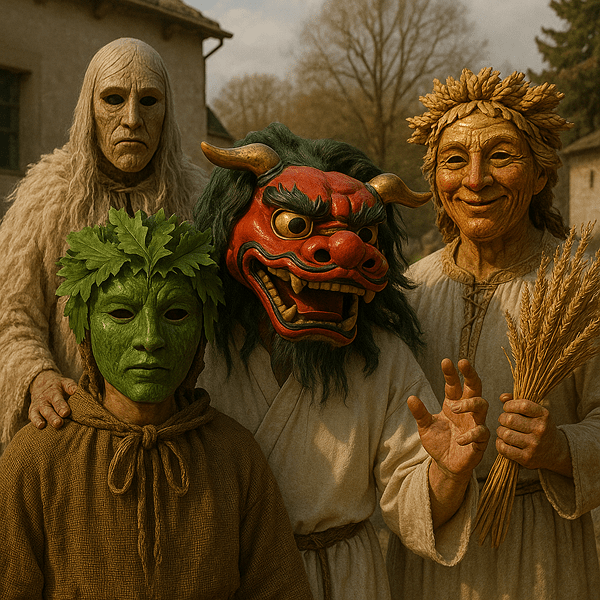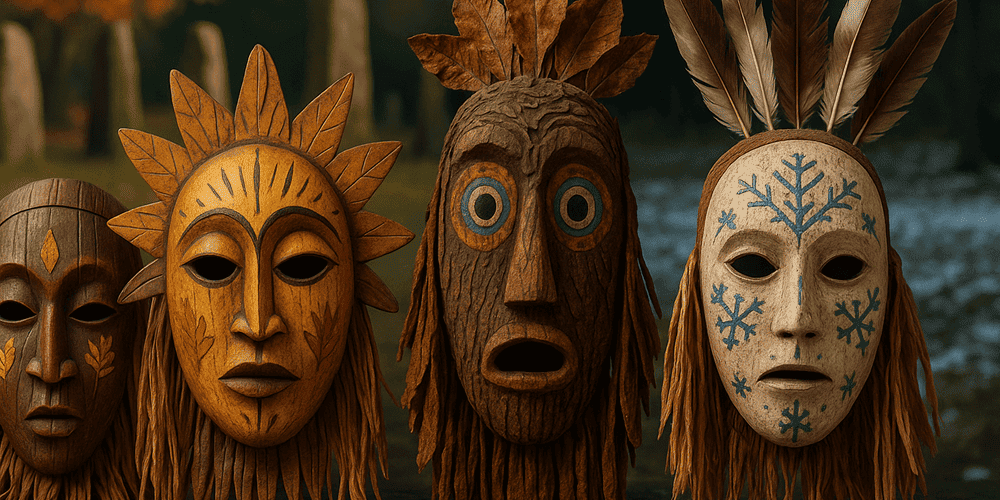Seasonal Ritual Masks — also known as festival or calendar masks — are among the most vivid and meaningful elements of traditional ceremonies worldwide. These masks are crafted and worn to mark key moments in the annual cycle: the changing of seasons, agricultural milestones, solstices, equinoxes, harvests, and communal festivals. Typically, Seasonal Ritual Masks feature motifs and decorations related to nature’s cycles: leaves, flowers, sun rays, snowflakes, fruits, and animals. Their colors shift with the seasons: lush greens for spring, bright yellows and reds for summer and autumn, cold whites and blues for winter. Their forms range from human faces to exaggerated animal or spirit visages, and they are often adorned with feathers, beads, raffia, and natural pigments. Seasonal Ritual Masks appear in the folk and religious traditions of Africa, Europe, Asia, and the Americas, reflecting humanity’s universal need to connect with the cycles of nature and time.
Historical Origins of Seasonal Ritual Masks
The origins of Seasonal Ritual Masks are deeply rooted in humanity’s agrarian and animistic past. The term “seasonal mask” refers to any mask used for rites that mark the passage of the year. The word “season” comes from the Latin “sationem,” meaning sowing or planting, reflecting the agricultural roots of many festivals. Ancient archaeological finds — rock carvings, cave paintings, and early burial sites — suggest that masks were used in spring fertility rites, harvest processions, and winter solstice ceremonies. In many societies, masks enabled participants to embody the spirits of the land, weather, or ancestors, ensuring good harvests and communal prosperity. Over centuries, the design and function of Seasonal Ritual Masks shifted with religious changes, the rise of urban festivals, and cultural exchange. Notable historical artifacts include Slavic winter masks, Japanese New Year lion masks, and West African yam festival masks. The evolution of these masks mirrors the adaptation of societies to climate, environment, and ritual needs. In some cultures, the healing and protective aspects of masks — as seen in Healing Masks — are integrated into seasonal celebrations.
Cultural Significance and Symbolism of Seasonal Ritual Masks
Seasonal Ritual Masks hold rich symbolic meaning in their native cultures. They are believed to embody the changing forces of nature: the renewal of spring, the abundance of harvest, the introspection of winter, or the intensity of summer. In ritual, the mask transforms its wearer into a spirit, animal, or deity associated with the season. For example, in European spring festivals, green-man masks symbolize growth and fertility; in Japanese Shishimai (lion dance), masks drive away evil and welcome a prosperous new year. Myths and legends often surround these masks — tales of winter spirits banished, harvest gods appeased, or ancestral blessings invoked. Socially, Seasonal Ritual Masks reinforce communal identity, transmit tradition, and create a space for both celebration and renewal. Religious aspects are central: masks mediate between human and supernatural realms, ensuring order and abundance in the natural world.

Materials and Craft Techniques of Seasonal Ritual Masks
The creation of Seasonal Ritual Masks is both an art and a ritual act. Traditional masks are carved from wood, molded from clay, woven from fibers, or assembled from bark, leaves, and animal hides. Artisans use knives, chisels, weaving tools, and sometimes fire to shape and embellish the mask. Decoration is seasonally symbolic: spring masks may be adorned with flowers, seeds, and bright paints; autumn masks with dried leaves, fruits, and earth tones; winter masks with fur, feathers, and cool colors; summer masks with sun motifs and lively ribbons. Regional differences are pronounced: in Mexico, Day of the Dead masks are painted with marigold and skull motifs; in West Africa, yam festival masks are decorated with river clay and cowrie shells. Color symbolism is crucial — green for growth, gold for ripeness, red for vitality, white for purity, blue for rain or sky. Special rituals often accompany the creation of the mask, imbuing it with seasonal and spiritual power.
Functions and Uses of Seasonal Ritual Masks
Seasonal Ritual Masks serve a variety of ceremonial, theatrical, and celebratory purposes. They are worn in rituals marking the new year, solstices, equinoxes, planting and harvest festivals, and communal feasts. The mask’s role is to channel seasonal spirits, invoke blessings, or drive away malevolent forces. In many cultures, masks are central to dances, processions, and dramatic performances that reenact mythological stories or dramatize the struggle between seasons (such as the battle of winter and summer). Seasonal masks may also be used in rites of passage, healing ceremonies, or as part of exorcisms and purification rituals. Over time, the use of Seasonal Ritual Masks has adapted to secular festivals, parades, and even tourism, while retaining their core symbolic meanings. Today, they are featured in cultural exhibitions, contemporary art, and revived folk traditions, demonstrating their continuing relevance.
Regional Variations of Seasonal Ritual Masks
Seasonal Ritual Masks display tremendous regional and cultural diversity. In Europe, spring and winter masks are used in Slavic, Germanic, and Mediterranean festivals — from the Slovenian Kurentovanje to the Swiss Fasnacht. In Japan, New Year and Obon masks symbolize seasonal spirits and ancestors. In Africa, yam and harvest festival masks from Nigeria and Ghana celebrate the bounty of the earth. The Americas feature masks for rainmaking, harvest, and Day of the Dead; in North America, Native American tribes use seasonal masks in ceremonial dances. Each region’s masks reflect local myths, ecology, and ritual needs, yet all share the goal of connecting people to the cycles of nature and time. Regional styles may differ in material, color palette, or symbolic motifs, but the spirit of renewal and celebration is universal.
Famous Examples and Collections of Seasonal Ritual Masks
Famous Seasonal Ritual Masks can be found in museums, folk festivals, and private collections worldwide. The Musée du Quai Branly (Paris), British Museum (London), and Smithsonian National Museum of the American Indian (Washington, D.C.) house important examples from Africa, Asia, and the Americas. Iconic masks include the Japanese Shishimai lion mask, European “Green Man” and Krampus masks, West African harvest masks, and Mexican Day of the Dead masks. Major folk festivals — such as the Venetian Carnival, Basel Fasnacht, and Mexican Dia de los Muertos — showcase seasonal masks in dramatic processions and performances. Archaeological finds and ethnographic collections provide insight into the evolution of seasonal mask traditions. Online resources and galleries, including toddmasks.com, make these masks accessible to a global audience.

Influence of Seasonal Ritual Masks on Art and Culture
Seasonal Ritual Masks have profoundly influenced visual art, music, literature, and performance. Their vibrant forms and motifs have inspired painters, sculptors, and costume designers, while their stories are retold in poetry, film, and folk music. In contemporary design, seasonal mask elements are adapted for festival costumes, jewelry, and home décor. The preservation and reinterpretation of seasonal mask traditions play a key role in cultural education, community identity, and creative innovation. Modern artists and performers draw on seasonal mask motifs to explore environmental themes, memory, and the connection between humanity and nature. Healing Masks, with their own ritual functions, sometimes overlap with seasonal masks in festivals and ceremonies focused on renewal, wellness, and community harmony.
Contemporary Status and Preservation of Seasonal Ritual Mask Traditions
Today, Seasonal Ritual Masks are celebrated in festivals, museums, and educational programs across the world. Artisans, folklorists, and cultural organizations support the creation, documentation, and teaching of mask-making traditions. Workshops, masterclasses, and community arts projects ensure the transmission of skills and stories to younger generations. Contemporary artists experiment with new materials and forms, bringing seasonal masks into contemporary art, theater, and fashion. Museums and online platforms like toddmasks.com offer research, virtual galleries, and public engagement. Preservation efforts focus on ethical collecting, safeguarding living traditions, and respecting the spiritual and ecological significance of masks in their original contexts.
Collecting and Acquiring Seasonal Ritual Masks
The market for Seasonal Ritual Masks is diverse, with authentic traditional pieces, high-quality replicas, and contemporary interpretations available from artisans, galleries, and online platforms. Prices vary widely depending on origin, craftsmanship, age, and cultural value. Collectors are encouraged to seek expert advice, verify provenance and authenticity, and support ethical and sustainable sources. Museums and folk organizations often offer certified reproductions and educational resources. Toddmasks.com provides expert guidance on collecting, authentication, and the cultural context of seasonal masks. Responsible collecting helps preserve both the tangible and intangible heritage of seasonal mask traditions.
